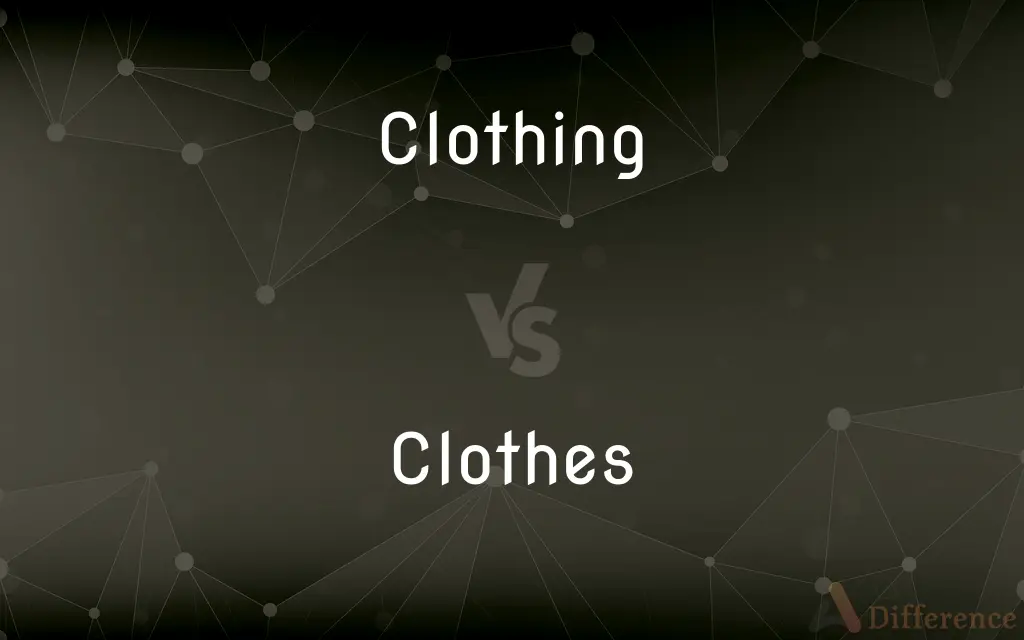Clothing vs. Clothes — What's the Difference?
By Fiza Rafique & Maham Liaqat — Updated on April 18, 2024
Clothing refers to any covering for the human body, while clothes specifically denote garments worn on the body for comfort or fashion.

Difference Between Clothing and Clothes
Table of Contents
ADVERTISEMENT
Key Differences
Clothing encompasses a wide range of coverings, including garments, accessories, and other wearable items that protect or adorn the body. On the other hand, clothes generally refer to pieces of fabric specifically designed to be worn, typically as attire for daily wear or special occasions.
Clothing can include items not typically classified as garments, such as hats, gloves, and scarves. Whereas, clothes are primarily made up of items like shirts, pants, dresses, and outerwear, essential for everyday dressing and functionality.
Clothing often carries broader cultural and historical connotations, representing traditions and societal norms through various styles and materials. In contrast, clothes are more focused on individual expression and practicality, reflecting personal style and environmental considerations.
The term 'clothing' is sometimes used in a more formal or collective sense to discuss subjects like clothing industry or protective clothing. On the other hand, 'clothes' is more colloquial, commonly used in everyday language when referring to one's outfit or wardrobe contents.
Clothing can also imply a more deliberate selection of attire for specific purposes, such as sports clothing or maternity clothing. Clothes, however, often denote the actual items worn day-to-day, without implying any specific function besides covering the body.
ADVERTISEMENT
Comparison Chart
Definition
Any coverings worn on the human body.
Garments specifically worn on the body.
Usage Context
Broader, includes accessories.
Generally limited to essential garments.
Connotations
Formal, collective.
Casual, everyday.
Types
Includes non-garments like hats.
Primarily garments like shirts, pants.
Purpose
Often functional (protection, adornment).
Mainly for comfort and fashion.
Compare with Definitions
Clothing
Any item worn to cover the body.
Traditional clothing often includes ceremonial accessories.
Clothes
Everyday wear in various settings.
She prefers casual clothes even at work.
Clothing
Coverings that serve a specific function.
Protective clothing is essential in hazardous environments.
Clothes
The contents of one's wardrobe.
His clothes varied from casual to business attire.
Clothing
The industry related to manufacturing garments.
She works in clothing design, focusing on sustainable fabrics.
Clothes
Specific outfits for occasions.
They wore special clothes for the festival.
Clothing
Garments collectively.
The display featured winter clothing from various cultures.
Clothes
Items worn to cover the body and provide comfort.
She packed light clothes for the summer trip.
Clothing
A general term for what one wears.
His choice of clothing was perfect for the formal event.
Clothes
Garments that can be washed and worn.
His clothes were always impeccably clean.
Clothing
Clothing (also known as clothes, apparel, and attire) are items worn on the body. Typically, clothing is made of fabrics or textiles, but over time it has included garments made from animal skin and other thin sheets of materials and natural products found in the environment, put together.
Clothes
Items worn to cover the body
He stripped off his clothes
Baby clothes
A clothes shop
Clothing
Clothes considered as a group; wearing apparel.
Clothes
Bedclothes
Rosie got into bed and pulled the clothes up to her nose
Clothing
A covering.
Clothes
(plural only) Items of clothing; apparel.
Clothing
Present participle of clothe
Clothes
(obsolete) cloth.
Clothing
Any of a wide variety of articles, usually made of fabrics, animal hair, animal skin, or some combination thereof, used to cover the human body for warmth, to preserve modesty, or for fashion.
You should wear warm clothing when it is cold outside.
All but two pieces of clothing came out of the washing machine stained.
A poncho is an item of clothing used by many people in Latin America.
A shirt is an article of clothing that covers the torso and arms.
Clothes
The covering of a bed; bedclothes.
Clothing
An act or instance of putting clothes on.
The clothing and unclothing of the idols was of special significance.
Clothes
Laundry (hung on a clothesline).
Clothing
(obsolete) The art or process of making cloth.
Clothes
Covering for the human body; dress; vestments; vesture; - a general term for whatever covering is worn, or is made to be worn, for decency or comfort.
She . . . speaks well, and has excellent good clothes.
If I may touch but his clothes, I shall be whole.
Clothing
A covering of non-conducting material on the outside of a boiler, or steam chamber, to prevent radiation of heat.
Clothes
The covering of a bed; bedclothes.
She turned each way her frighted head,Then sunk it deep beneath the clothes.
Clothing
Garments in general; clothes; dress; raiment; covering.
From others he shall stand in need of nothing,Yet on his brothers shall depend for clothing.
As for me, . . . my clothing was sackloth.
Clothes
Clothing in general;
She was refined in her choice of apparel
He always bought his clothes at the same store
Fastidious about his dress
Clothing
The art of process of making cloth.
Instructing [refugees] in the art of clothing.
Clothing
A covering of non-conducting material on the outside of a boiler, or steam chamber, to prevent radiation of heat.
Clothing
See Card clothing, under 3d Card.
Clothing
A covering designed to be worn on a person's body
Common Curiosities
How do cultural differences affect the use of the terms clothing and clothes?
Cultural variations can influence whether an item is considered clothing or clothes, particularly in terms of traditional or ceremonial wear.
Can clothing be rented while clothes cannot?
Both clothing and clothes can be rented, especially in contexts like formal wear or fashion, but typically, everyday clothes are less commonly rented than special occasion clothing.
Why do people use the term 'clothing' in business?
The term 'clothing' is often used in business to encompass a wide range of wearable products, not limited to everyday garments.
What is the impact of technology on clothing vs. clothes?
Technology impacts both, with innovations in materials and manufacturing processes enhancing functionality in clothing and style in clothes.
What is meant by children’s clothing?
Children’s clothing refers to garments designed specifically for children, including sizes and styles suitable for various ages.
How are clothing and clothes handled in recycling?
Both are recycled but may be processed differently based on material and condition; clothing accessories might require different recycling techniques than clothes.
How do laundering practices differ between clothing and clothes?
General clothes are regularly washed and cared for at home, whereas certain clothing items, especially those with functional purposes, may require special care.
Is there a difference in purchasing habits for clothing vs. clothes?
Purchasing habits may differ; clothing purchases can be driven by need or function (like sports clothing), while clothes might be bought more for aesthetic or fashion purposes.
What role does sustainability play in clothing and clothes?
Sustainability is a growing focus in both sectors, with an emphasis on reducing the environmental impact of producing and disposing of clothing and clothes.
What legal regulations affect clothing and clothes differently?
Legal regulations can affect clothing, such as safety standards for protective gear, more stringently than general clothes.
What are examples of clothing that are not clothes?
Clothing can include accessories like belts, hats, and scarves, which are not typically categorized as clothes.
How does the fashion industry define clothes?
In fashion, clothes are often defined as the garments that can be worn, including dresses, pants, and shirts, focusing on trends and seasonal wear.
How do trends affect the production of clothing vs. clothes?
Trends heavily influence clothes production in terms of style and fashion cycles, while clothing trends might also include technological advancements and functional design changes.
What terminology is used in different regions for clothing vs. clothes?
Terminology can vary, with some English-speaking regions using "clothes" more colloquially, while "clothing" might be used more formally or in written English.
How does online shopping affect the sales of clothing vs. clothes?
Online shopping has boosted sales for both, but clothes might see more frequent purchases due to ease of choice and return policies suited to standard garments.
Share Your Discovery

Previous Comparison
Flubber vs. Clubber
Next Comparison
Ductility vs. BrittlenessAuthor Spotlight
Written by
Fiza RafiqueFiza Rafique is a skilled content writer at AskDifference.com, where she meticulously refines and enhances written pieces. Drawing from her vast editorial expertise, Fiza ensures clarity, accuracy, and precision in every article. Passionate about language, she continually seeks to elevate the quality of content for readers worldwide.
Co-written by
Maham Liaqat













































